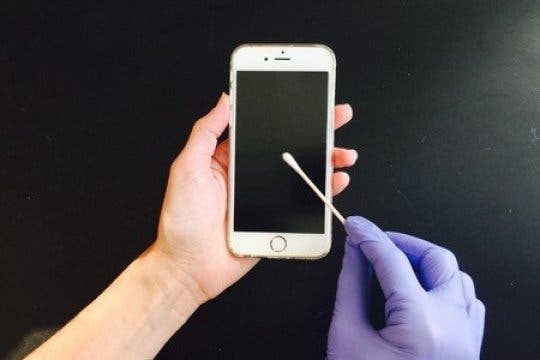The mobile phone is often at the core of our modern lifestyle, and that says many things about us in itself. But researchers now believe that they can learn a lot more just by analyzing its screen.

Mirror mirror on the wall, your mobile’s phone screen sees it all. Credit: Amina Bouslimani and Neha Garg
Every time we touch something, we leave behind trace molecules, indicators of the bio-chemistry of our bodies — and there are fewer objects we touch more often than our mobile phones. By analyzing the molecules on phone screens, US scientists were able to reconstruct big chunks of volunteers’ lifestyle, including diet, preferred hygiene products, health status, and locations visited. Even though volunteers were instructed to not use any healthcare products for three days, the traces were still clearly visible.
“All of these chemical traces on our bodies can transfer to objects,” senior author Pieter Dorrestein, PhD, professor in UC San Diego School of Medicine and Skaggs School of Pharmacy and Pharmaceutical Sciences. “So we realized we could probably come up with a profile of a person’s lifestyle based on chemistries we can detect on objects they frequently use.”
Among the identified substances were anti-inflammatory and anti-fungal skin creams, hair loss treatments, anti-depressants, and eye drops – so both internal and external things. There’s good reason to believe that everything you use can be traced back. Food molecules were also detected: citrus, caffeine, herbs and spices were the most prevalent. Meanwhile, insect repellants were detected even though they had been used months before. In other words, the molecules on the phones say quite a lot about the phone’s owner.
“By analyzing the molecules they’ve left behind on their phones, we could tell if a person is likely female, uses high-end cosmetics, dyes her hair, drinks coffee, prefers beer over wine, likes spicy food, is being treated for depression, wears sunscreen and bug spray — and therefore likely spends a lot of time outdoors — all kinds of things,” said first author Amina Bouslimani, PhD, an assistant project scientist in Dorrestein’s lab. “This is the kind of information that could help an investigator narrow down the search for an object’s owner.”
This is an innovative approach which could have an array of potential applications, especially in a legal framework.
“You can imagine a scenario where a crime scene investigator comes across a personal object — like a phone, pen or key — without fingerprints or DNA, or with prints or DNA not found in the database. They would have nothing to go on to determine who that belongs to,” Dorrestein added “So we thought — what if we take advantage of left-behind skin chemistry to tell us what kind of lifestyle this person has?
But the team emphasizes that there are other applications as well: medicine, environmental studies, airport screening, or adherence monitoring. For instance, a physician could check if a patient is sticking to the prescription, or exposure to hazardous substances could be studied by analyzing skin metabolites.
Moving forward, they are already working on an even bigger trial, focusing on other objects we often touch during the day, such as wallets and keys.
Journal Reference: Pieter C. Dorrestein et al. Lifestyle chemistries from phones for individual profiling. PNAS, November 2016 DOI: 10.1073/pnas.1610019113









